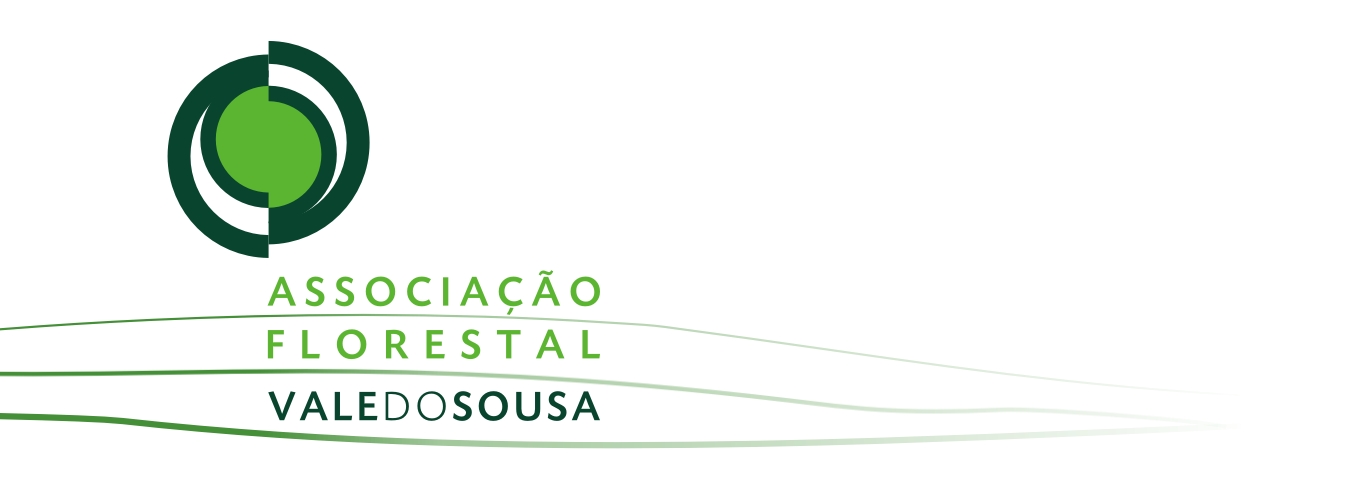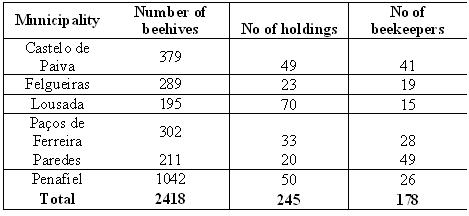76706 ha
Forest area in Sousa Valley (2005):
29274,16 ha
Cost
TOTAL COST:
120,6 €
This cost include:
1 – Data collection 75,6 €
3-Data analysis 45 €
Results
Number of beehives in Sousa Valley per municipality in 1999
Source: Recenseamento Geral Agrícola, 1999 in O país em números, Versão 2, Instituto Nacional de Estatística, 2004.
Local sources confirmed this number based on their knowledge about the activity (2005).
Honey productivity per beehive
Sources: 1 Programa apícola 2004-2007;
2 Local beekeepers (2005)
Average price of the honey at the beekeepers’ gate in Sousa Valley in 2005
Source : Local beekeepers
According to local beekeepers the main production is exported and paid at 1, 5 €/Kg
| Value of honey production in Sousa Valley in 2005: 72540 € |
Remarks
Apart from game (see C6), honey is the main non wood forest product (NWFP) produced in Sousa Valley. Honey production can have two objectives:
a)Commercial purposes, bringing extra income to the forest owners and farmers;
b)Own consumption.
According to local sources (mainly from Penafiel), a significant part of the production is bought by middle men and then exported to Germany.
There are high evidences of the importance of beekeeping activity in Sousa Valley:
a) More than 8 places (in 35 visited) with beehives were seen during the field work by the field team;
b) There are two enterprises established in Sousa Valley that produce and sell material for beekeeping. This suggests that exist demand for this type of material;
c) Data published by the National Institute of Statistics and data provided by the Regional Direction of Agriculture concerning the number of beehives in the 6 municipalities of Sousa Valley and the numbers given by local sources.
The marketing of honey can be done in two different ways:
a) Sold by the producer directly to the consumers;
b) Sold by the producer to middle men who sell it to honey processing enterprises, mainly located in Germany.
In Sousa Valley, Penafiel is the municipality where more beehives are registered: 1042 beehives in 1999.
One considers that the number of beehives has been almost the same in Sousa Vally since 1999.
According to local sources, Sousa Valley is propitious to the production of honey and being the average productivity of honey per beehive a little higher than the average productivity of honey per beehive in Continental Portugal.
Big part of the production of honey in Sousa Valley is exported and paid at 1,5 €/kg by middle men to honey producers.
Considering data collected, the total value of honey production in Sousa Valley in 2005 is 72540 €.
Problems and Improvements
According to the General Direction of Agriculture of Entre-Douro and Minho (Direcção Regional de Agricultura de Entre Douro e Minho, DRAEDM in Portuguese initials) located in Penafiel, data on the number of beehives is reliable once the producers have a benefit for registering close to the official entitites the right number of beehives they own. This benefit consists on getting sanitarian products against bee’s diseases for free. The amount of sanitarian products they can get depends on the number of beehives owned.
During the data collection, it was noticed that the number of beehives in Sousa Valley given by INE and the number of beehives in Sousa Valley given by DRAEDM were exactly the same. However, DRAEM claims that data collected by INE in 1999 through the General Agricultural Censuses (Recenseamento Geral Agrícola) is totally independent from data collected by DRAEM.
Comments and conclusion
The production of NWFP is important since it can be a way to increase the income of forest owners.
Although the forest in Sousa Valley has been mainly a production forest, there are signs of decline in the prices of wood products and increase of the importance of NWFPs.
These types of products should already be taken into account in the projects of Sustainable Forest Management of the region.
In 2005, honey and game were the main NWFPs produced there, but the production of edible mushrooms and aromatic plants has been encouraged by the local FOA.
With that purpose AFVS organised some field visits and training actions under the project AGRIS 8, to inform the forest owners how to produce NWFPs.
Other productions is one of the indicators of Criterion 3 considered by NP 4406 2003. NP 4406 2003 considers that forests can produce a diversified sort of goods and services besides the main product. Although most of those goods and services are not marketed in a structured market there are others for which the market is well established and organised. In these cases the diversification of the production is desirable because it reduces the dependence against market fluctuations associated to the main forest product and increases the total revenues of the forest holdings.
In Sousa Valley, honey and game are other forest productions.




Initiative Communaitaire FEDER
INTERREG IIIB Espace Atlantique


